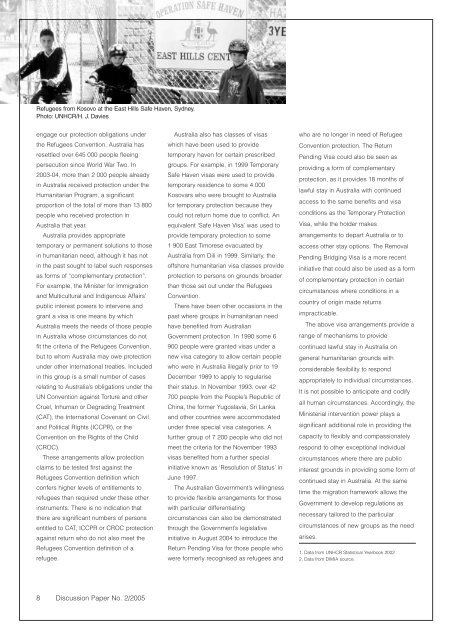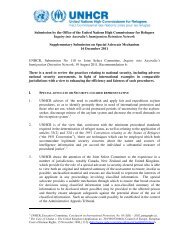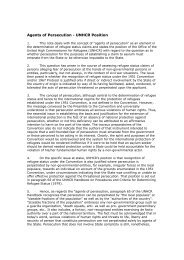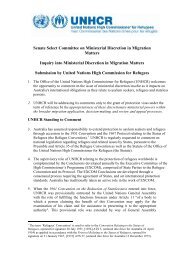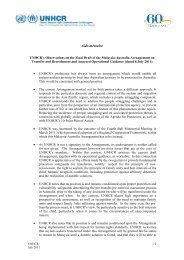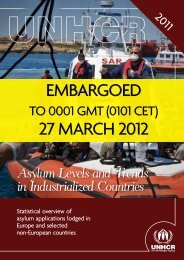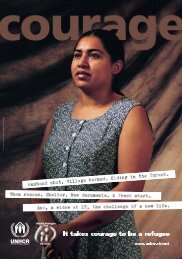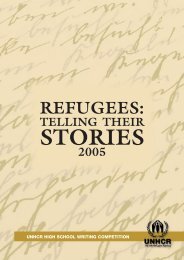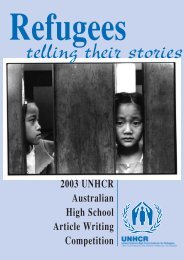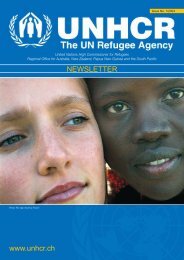Refugee Newsletter - unhcr
Refugee Newsletter - unhcr
Refugee Newsletter - unhcr
Create successful ePaper yourself
Turn your PDF publications into a flip-book with our unique Google optimized e-Paper software.
<strong>Refugee</strong>s from Kosovo at the East Hills Safe Haven, Sydney.Photo: UNHCR/H. J. Daviesengage our protection obligations underthe <strong>Refugee</strong>s Convention. Australia hasresettled over 645 000 people fleeingpersecution since World War Two. In2003-04, more than 2 000 people alreadyin Australia received protection under theHumanitarian Program, a significantproportion of the total of more than 13 800people who received protection inAustralia that year.Australia provides appropriatetemporary or permanent solutions to thosein humanitarian need, although it has notin the past sought to label such responsesas forms of “complementary protection”.For example, the Minister for Immigrationand Multicultural and Indigenous Affairs’public interest powers to intervene andgrant a visa is one means by whichAustralia meets the needs of those peoplein Australia whose circumstances do notfit the criteria of the <strong>Refugee</strong>s Convention,but to whom Australia may owe protectionunder other international treaties. Includedin this group is a small number of casesrelating to Australia’s obligations under theUN Convention against Torture and otherCruel, Inhuman or Degrading Treatment(CAT), the International Covenant on Civiland Political Rights (ICCPR), or theConvention on the Rights of the Child(CROC).These arrangements allow protectionclaims to be tested first against the<strong>Refugee</strong>s Convention definition whichconfers higher levels of entitlements torefugees than required under these otherinstruments. There is no indication thatthere are significant numbers of personsentitled to CAT, ICCPR or CROC protectionagainst return who do not also meet the<strong>Refugee</strong>s Convention definition of arefugee.Australia also has classes of visaswhich have been used to providetemporary haven for certain prescribedgroups. For example, in 1999 TemporarySafe Haven visas were used to providetemporary residence to some 4 000Kosovars who were brought to Australiafor temporary protection because theycould not return home due to conflict. Anequivalent ‘Safe Haven Visa’ was used toprovide temporary protection to some1 900 East Timorese evacuated byAustralia from Dili in 1999. Similarly, theoffshore humanitarian visa classes provideprotection to persons on grounds broaderthan those set out under the <strong>Refugee</strong>sConvention.There have been other occasions in thepast where groups in humanitarian needhave benefited from AustralianGovernment protection. In 1990 some 6900 people were granted visas under anew visa category to allow certain peoplewho were in Australia illegally prior to 19December 1989 to apply to regularisetheir status. In November 1993, over 42700 people from the People’s Republic ofChina, the former Yugoslavia, Sri Lankaand other countries were accommodatedunder three special visa categories. Afurther group of 7 200 people who did notmeet the criteria for the November 1993visas benefited from a further specialinitiative known as ‘Resolution of Status’ inJune 1997.The Australian Government’s willingnessto provide flexible arrangements for thosewith particular differentiatingcircumstances can also be demonstratedthrough the Government’s legislativeinitiative in August 2004 to introduce theReturn Pending Visa for those people whowere formerly recognised as refugees andwho are no longer in need of <strong>Refugee</strong>Convention protection. The ReturnPending Visa could also be seen asproviding a form of complementaryprotection, as it provides 18 months oflawful stay in Australia with continuedaccess to the same benefits and visaconditions as the Temporary ProtectionVisa, while the holder makesarrangements to depart Australia or toaccess other stay options. The RemovalPending Bridging Visa is a more recentinitiative that could also be used as a formof complementary protection in certaincircumstances where conditions in acountry of origin made returnsimpracticable.The above visa arrangements provide arange of mechanisms to providecontinued lawful stay in Australia ongeneral humanitarian grounds withconsiderable flexibility to respondappropriately to individual circumstances.It is not possible to anticipate and codifyall human circumstances. Accordingly, theMinisterial intervention power plays asignificant additional role in providing thecapacity to flexibly and compassionatelyrespond to other exceptional individualcircumstances where there are publicinterest grounds in providing some form ofcontinued stay in Australia. At the sametime the migration framework allows theGovernment to develop regulations asnecessary tailored to the particularcircumstances of new groups as the needarises.1. Data from UNHCR Statistical Yearbook 2002.2. Data from DIMIA source.8 Discussion Paper No. 2/2005


